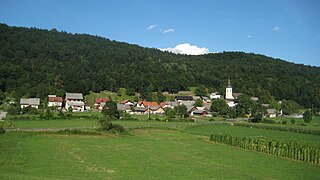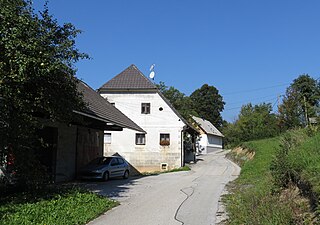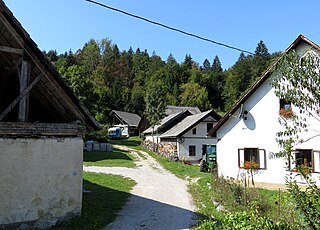
Klinja Vas is a village north of Kočevje in southern Slovenia. The area is part of the traditional region of Lower Carniola and is now included in the Southeast Slovenia Statistical Region.

Koprivnik is a settlement in the Municipality of Kočevje in southern Slovenia. It was a village settled by Gottschee Germans until 1941. During the Second World War its original population was expelled. The area is part of the traditional region of Lower Carniola and is now part of the Southeast Slovenia Statistical Region.

Mozelj is a settlement in the Municipality of Kočevje in southern Slovenia. It was a village inhabited mostly by Gottschee Germans. During the Second World War its original population was expelled. The area is part of the traditional region of Lower Carniola and is now included in the Southeast Slovenia Statistical Region.

Novi Lazi is a settlement east of Kočevska Reka in the Municipality of Kočevje in southern Slovenia. The area is part of the traditional region of Lower Carniola and is now included in the Southeast Slovenia Statistical Region. After the Second World War it also included Jelenja Vas, formerly a separate village named Iskrba, which is now a hamlet of Štalcerji.

Polom is a settlement in the Municipality of Kočevje in southern Slovenia. The area is part of the traditional region of Lower Carniola and is now included in the Southeast Slovenia Statistical Region.

Rajhenav is an abandoned settlement in the Municipality of Kočevje in southern Slovenia. The area is part of the traditional region of Lower Carniola and is now included in the Southeast Slovenia Statistical Region.

Smuka is a settlement in the Municipality of Kočevje in southern Slovenia. It was a village inhabited by Gottschee Germans. In 1941 at the beginning of the Second World War its original population was evicted. The area is part of the traditional region of Lower Carniola and is now included in the Southeast Slovenia Statistical Region. A cave known as Štavka or Štibloh is located near the village, in the direction of Stari Log.

Stara Cerkev is a village northwest of Kočevje in southern Slovenia. The area is part of the traditional region of Lower Carniola and is now included in the Southeast Slovenia Statistical Region.
Stari Breg is a settlement in the hills north of the town of Kočevje in southern Slovenia. The area is part of the traditional region of Lower Carniola and is now included in the Southeast Slovenia Statistical Region.

Kočevske Poljane is a village in the Municipality of Dolenjske Toplice in Slovenia. The area is part of the historical region of Lower Carniola. The municipality is now included in the Southeast Slovenia Statistical Region. The village includes the hamlets of Gorica and Trnovec.

Mali Rigelj is a small settlement in the Municipality of Dolenjske Toplice in Slovenia. The area is part of the historical region of Lower Carniola. The municipality is now included in the Southeast Slovenia Statistical Region.

Občice is a small settlement in the Municipality of Dolenjske Toplice in Slovenia. It lies on the eastern edge of the Gottschee region. The area is part of the historical region of Lower Carniola. The municipality is now included in the Southeast Slovenia Statistical Region.

Stare Žage is a settlement in the Municipality of Dolenjske Toplice in Slovenia. The area is part of the historical region of Lower Carniola. The municipality is now included in the Southeast Slovenia Statistical Region.
Hrib pri Koprivniku is a remote almost abandoned settlement in the Municipality of Kočevje in southern Slovenia. The area is part of the traditional region of Lower Carniola and is now included in the Southeast Slovenia Statistical Region.
Pugled pri Starem Logu is an abandoned settlement in the hills north of the town of Kočevje in southern Slovenia. The area is part of the traditional region of Lower Carniola and is now included in the Southeast Slovenia Statistical Region.
Gače is a remote abandoned settlement in the Municipality of Semič in southern Slovenia. The area is part of the traditional region of Lower Carniola and is now included in the Southeast Slovenia Statistical Region. Its territory is now part of the village of Komarna Vas and it is registered as a cultural heritage site.
Mašelj is a small settlement in the Municipality of Semič in Slovenia. The area is part of the historical region of Lower Carniola. The municipality is now included in the Southeast Slovenia Statistical Region. Mašelj is known locally as Graben. The settlement has no permanent residents today.

Kleč is a remote former settlement in the Municipality of Semič in southern Slovenia. The area is part of the traditional region of Lower Carniola and is now included in the Southeast Slovenia Statistical Region. Its territory is now part of the village of Planina.
Kuhlarji is a village in the Municipality of Kočevje in southern Slovenia. The area is part of the traditional region of Lower Carniola and is now included in the Southeast Slovenia Statistical Region. It no longer has any permanent residents.
Verderb is a former village in the Municipality of Kočevje in southern Slovenia. The area is part of the traditional region of Lower Carniola and is now included in the Southeast Slovenia Statistical Region. Its territory is now part of the village of Podlesje.
















